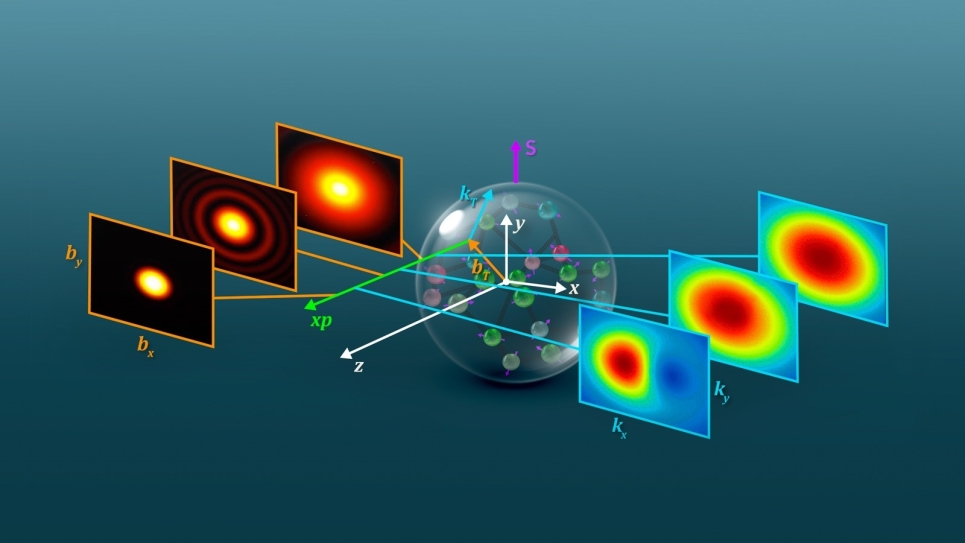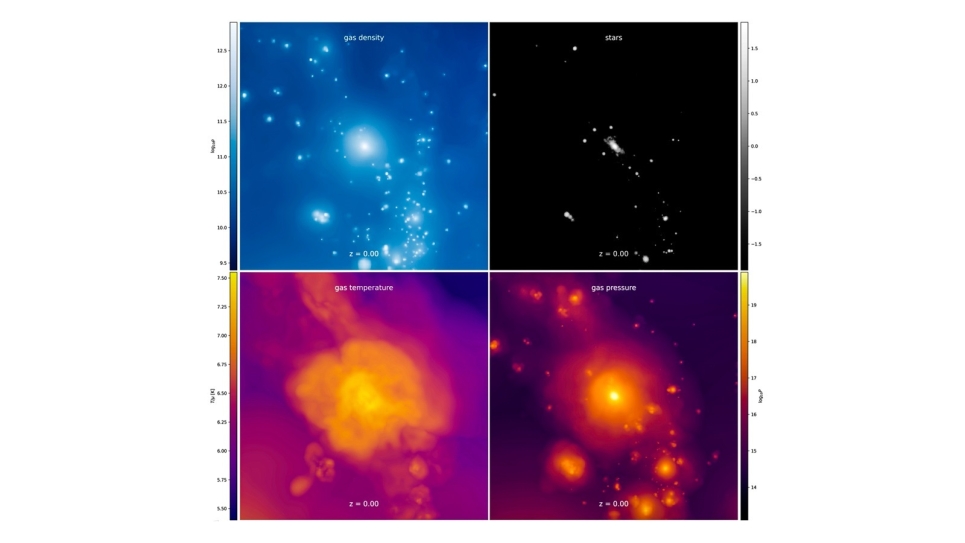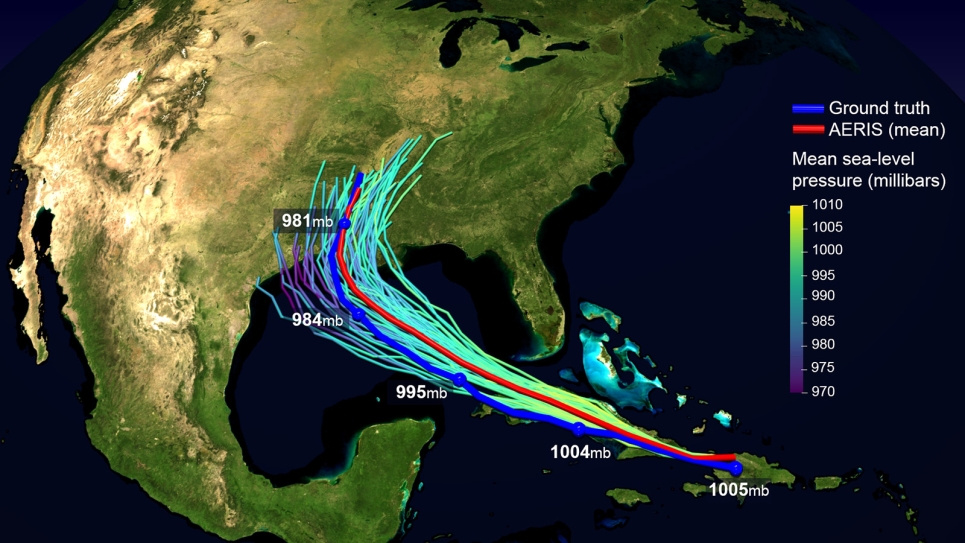The SciDAC program in nuclear physics funded three multi-institution projects for a total of $35 million. Researchers from Argonne will participate in all three projects and lead one. Leading “Femtoscale Imaging of Nuclei Using Exascale Platforms,” Ian Cloët, an Argonne theoretical physicist, will work with partners from DOE’s Thomas Jefferson National Accelerator Facility and Virginia Polytechnic Institute and State University to develop a new framework for extracting 3D images of nucleons from experimental data. Together they are hoping to find new discoveries on the nature of matter at extremely small length scales — the so-called femtoscale, corresponding to a quadrillionth of a meter.
The SciDAC program in high energy physics funded five projects, for a total of $30 million. One project is led by Argonne physicist and computational scientist, Katrin Heitmann. (Other participating institutions are DOE’s Lawrence Berkeley and Los Alamos national laboratories and Virginia Tech.) “Enabling Cosmic Discoveries in the Exascale Era” will use exascale supercomputers to create models and simulations from new cosmological survey datasets. It will study the universe’s origin and evolution. Combined with observations, the model predictions are crucial to exploring new insights into dark matter and dark energy.
The two Argonne-led projects will support pioneering research on DOE’s exascale supercomputers including Aurora, the next-generation system being built at the Argonne Leadership Computing Facility, a DOE Office of Science user facility at Argonne.
“The SciDAC program is an excellent example of the kind of uniquely impactful work that can be performed by cross-disciplinary teams joining hands across scientific domain boundaries,” said Salman Habib, director of Argonne’s Computational Science division. “Much of the future of science rests on the success of endeavors that bring together cutting-edge computing and innovative scientific ideas.”
Additional SciDAC projects Argonne is participating in:
Nuclear Physics
The SciDAC Partnership in Nuclear Physics will involve experts in nuclear physics and software development, as well as applied mathematics and computer science. These projects will use supercomputers to develop new algorithms and software.
SciDAC‐5 Nuclear Computational Low Energy Initiative (NUCLEI)
- Argonne principal investigator: Matt Menickelly
- Argonne researchers: Alessandro Lovato, Sri Hari Krishna Narayanan, Jared O’Neal, Krishnan Raghavan, Ragnar Stroberg and Robert (Bob) Wiringa
- Led by: Oak Ridge National Laboratory
Fundamental Nuclear Physics at the Exascale and Beyond
- Argonne principal investigator: Prasanna Balaprakash
- Argonne researcher: Rob Latham
- Led by: Thomas Jefferson National Accelerator Facility
High Energy Physics
The aim of the SciDAC Partnership in High Energy Physics is to use DOE high performance computers to help understand the universe. These projects will develop new computation and simulation techniques and tools.
Next Generation Precision for Neutrino and Collider Computations
- Argonne principal investigators: Alessandro Lovato and Anshu Dubey
- Argonne researchers: Taylor Childers, Carlo Graziani and Paul Hovland
- Led by: Fermi National Accelerator Laboratory
Celeritas: GPU-Accelerated Particle Transport for Detector Simulation in High Energy Physics Experiments
- Argonne principal investigator: Paul Romano
- Argonne researchers: Amanda Lund
- Led by: Oak Ridge National Laboratory
Multiscale Acceleration: Powering Future Discoveries in High Energy Physics
- Argonne principal investigators: James Osborn and Xiao-Yong Jin
- Led by: Brookhaven National Laboratory
Collaboration for Advanced Modeling of Particle Accelerators
- Argonne principal investigator: Jeff Larson
- Argonne researchers: Stephen Hudson
- Led by: Lawrence Berkeley National Laboratory
Earth System Model Development
The SciDAC Partnerships in Earth System Model Development brings together earth system scientists, applied mathematicians and computer scientists. Their goal is to accelerate and enhance the DOE’s Energy Exascale Earth System Model (E3SM).
MPAS‐O/ROMS Comparison, Nesting, and Coupling for Improved Representation and Parameterization of Coastal and Submesoscale Ocean Processes in E3SM
- Argonne principal investigator: Iulian Grindeanu
- Argonne researchers: Vijay Mahadevan
- Led by: Pacific Northwest National Laboratory
Improving Projections of AMOC and its Collapse Through Advanced Simulations (ImPACTS)
- Argonne principal investigator: Sri Hari Krishna Narayanan
- Argonne researchers: Prasanna Balaprakash, Steve Brus, Jan Hückelheim, Tom Peterka, Yixuan Sun and Orcun Yildiz.
- Led by: Los Alamos National Laboratory
Also contributing to “Femtoscale Imaging of Nuclei Using Exascale Platforms,” are Argonne’s Ahmed Attia, Julie Bessac, Taylor Childers, Emil Constantinescu, Anshu Dubey, Hanqi Guo, Sylvester Joosten, Todd Munson, Nesar Ramachandra and Xingfu Wu. Argonne’s Jeffrey Emberson, Nicholas Frontiere, Salman Habib, Andrew Hearin, Patricia Larsen, Rob Latham, Sandeep Madireddy, Nesar Ramachandra and Esteban Rangel will also contribute to “Enabling Cosmic Discoveries in the Exascale Era.”
==========
The Argonne Leadership Computing Facility provides supercomputing capabilities to the scientific and engineering community to advance fundamental discovery and understanding in a broad range of disciplines. Supported by the U.S. Department of Energy’s (DOE’s) Office of Science, Advanced Scientific Computing Research (ASCR) program, the ALCF is one of two DOE Leadership Computing Facilities in the nation dedicated to open science.
Argonne National Laboratory seeks solutions to pressing national problems in science and technology. The nation's first national laboratory, Argonne conducts leading-edge basic and applied scientific research in virtually every scientific discipline. Argonne researchers work closely with researchers from hundreds of companies, universities, and federal, state and municipal agencies to help them solve their specific problems, advance America's scientific leadership and prepare the nation for a better future. With employees from more than 60 nations, Argonne is managed by UChicago Argonne, LLC for the U.S. Department of Energy's Office of Science.
The U.S. Department of Energy's Office of Science is the single largest supporter of basic research in the physical sciences in the United States and is working to address some of the most pressing challenges of our time. For more information, visit https://energy.gov/science




